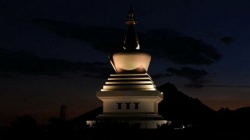Difference between revisions of "Cetiya"
Jump to navigation
Jump to search
| Line 1: | Line 1: | ||
[[File:E-lapse.jpg|thumb|250px|]] | [[File:E-lapse.jpg|thumb|250px|]] | ||
| − | The [[cetiya]], "reminders" or "memorials" ([[Sanskrit]]: [[caitya]]), are [[objects]] and places used by [[Theravada]] [[Buddhists]] to remember [[Gautama]] [[Buddha]]. These are [[traditionally]] divided into [[three categories]]: [[śarīraka]], pieces of the [[body]], [[paribhogaka]], things he used, and [[udeśaka]], reminders. A fourth category, [[dhammaka]], was added later to remind [[monks]] that the true [[memory]] of [[Gautama]] [[Buddha]] can be found in his teachings. While these can be broadly called [[Buddhist]] [[symbolism]], the {{Wiki|emphasis}} tends to be on a historical connection to the [[Buddha]] and not a [[metaphysical]] one. | + | |
| + | |||
| + | |||
| + | |||
| + | |||
| + | |||
| + | The [[cetiya]], "reminders" or "memorials" ([[Sanskrit]]: [[caitya]]), are [[objects]] and places used by [[Theravada]] [[Buddhists]] to remember [[Gautama]] [[Buddha]]. These are [[traditionally]] divided into [[three categories]]: [[śarīraka]], pieces of the [[body]], [[paribhogaka]], things he used, and [[udeśaka]], reminders. A fourth category, [[dhammaka]], was added later to remind [[monks]] that the true | ||
| + | |||
| + | [[memory]] of [[Gautama]] [[Buddha]] can be found in his teachings. While these can be broadly called [[Buddhist]] [[symbolism]], the {{Wiki|emphasis}} tends to be on a historical [[connection]] to the [[Buddha]] and not a [[metaphysical]] one. | ||
| + | |||
| + | |||
{{W}} | {{W}} | ||
{{PaliTerminology}} | {{PaliTerminology}} | ||
[[Category:Buddhist Symbols]] | [[Category:Buddhist Symbols]] | ||
Latest revision as of 12:27, 5 January 2024
The cetiya, "reminders" or "memorials" (Sanskrit: caitya), are objects and places used by Theravada Buddhists to remember Gautama Buddha. These are traditionally divided into three categories: śarīraka, pieces of the body, paribhogaka, things he used, and udeśaka, reminders. A fourth category, dhammaka, was added later to remind monks that the true
memory of Gautama Buddha can be found in his teachings. While these can be broadly called Buddhist symbolism, the emphasis tends to be on a historical connection to the Buddha and not a metaphysical one.
